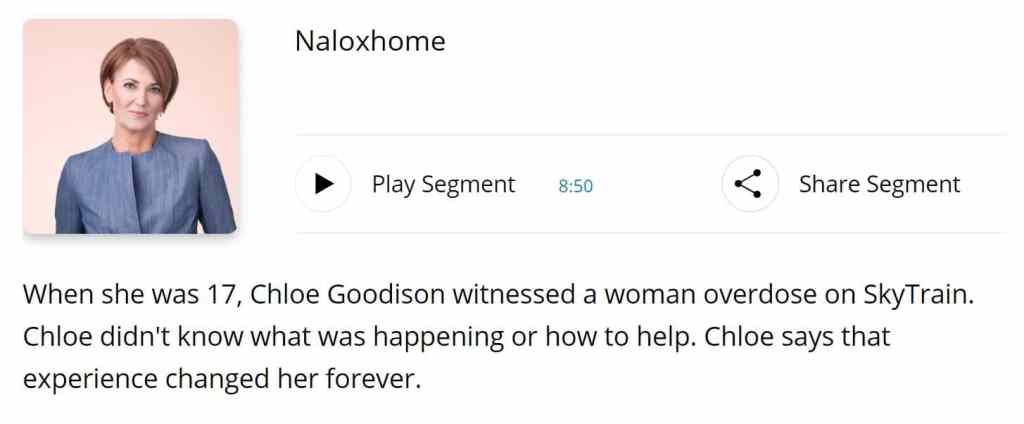Chloe Goodison NaloxHome Chloe Goodison NaloxHome Chloe Goodison NaloxHome
Confused is the best word to describe my mind after witnessing my first overdose. Cold and pale against my lap, I looked into rolled-back eyes and saw a woman similar to myself—young in age, wearing a hoodie with her high school’s logo on it, holding a pink iPhone case. Immediately, my first aid knowledge of chest compressions and the Heimlich maneuver—learned in high school PE classes—slipped my mind, as she suffered right there in front of me. Other passengers crowded, each offering suggestions of “eating disorder” or “diabetic coma.” The young woman fell unconscious and was pulled from the train to be treated by EMS. Later that day, I was informed that the young woman had overdosed.

It was 2019. At this point, British Columbia (BC) was over three years into a declared public health emergency. Yes, I was confused why this girl, around my own age, was suffering. But perhaps more perplexing is that on a busy SkyTrain, nobody was able to recognize the signs of overdose or inject naloxone. This is not an issue of each individual SkyTrain rider—it is an issue of the education system, and society, for failing to teach us about the prevalence of overdose in BC and the easy accessibility to naloxone. By suppressing this knowledge, we create stigma, and this stigma propels the overdose crisis.
READ MORE: The impact of stigma
With guidance from community partners, I’m vying to change the lack of sharing about harm reduction, the toxic drug supply, overdose, and naloxone in my local school district (Coquitlam, SD43). I’ve received approval from officials at Fraser Health, SD43, and many other organizations to get the ball rolling. By winning the 2020-2021 SFU Student Community Engagement Competition, my project, NaloxHome, has financial support.
Currently, I am recruiting local young adults, aged 18-25, to be “youth educators” at NaloxHome. It’s important to collect a broad range of volunteers, varying in race, sexual orientation, criminal background, and level of education. I am thoroughly of the belief that if someone wants to help in making a positive change in their community, nothing should be stopping them from doing so. As well, as we are presenting in high schools, I want students to feel connected and represented by each presenter.
“I am thoroughly of the belief that if someone wants to help in making a positive change in their community, nothing should be stopping them from doing so.”
Once this team is assembled, we’ll start our group training. Fraser Health, my local health district, has provided me with information and important messages to include in NaloxHome’s presentation to students. We’ll have the team become experts on this info, and we’ll practice presentation skills. The information we’re sharing includes overdose statistics, signs of an overdose, the Good Samaritan Overdose Act, and accessible naloxone training. Local high schools will have the opportunity to “book” a NaloxHome presentation (virtually!) in classes. We will relay the aforementioned information to students, ranging from grade 10-12.
I graduated high school in 2020 and can confidently say that I went through grades 9-12 without learning of the overdose epidemic around me. Though I can’t change this statement for myself, I can influence it for others. The question that looms over my head is, “if I had received a presentation from NaloxHome, would I have known how to help the woman on the SkyTrain?” Through NaloxHome’s outreach, I hope my experience becomes a situation of the past—for everyone.
I’ve always believed that education is power. Port Moody’s fire chief, Ron Coulson, said, “Success will be easily measured when one life is positively impacted,” in regards to NaloxHome. It’s true—at the least, we’re opening students’ eyes to the overdose crisis we’re living in. At most, we’re equipping them with naloxone, saving a life, and sparking inspiration to continue advocacy. As a student at Simon Fraser Univeristy in Health Sciences, I’ve learned that early intervention, prevention, and harm reduction should be of greater value than treatment. Naloxone saves lives, and the overdose crisis hits too close to home. These two simple reasons contribute greatly to the development of NaloxHome.

